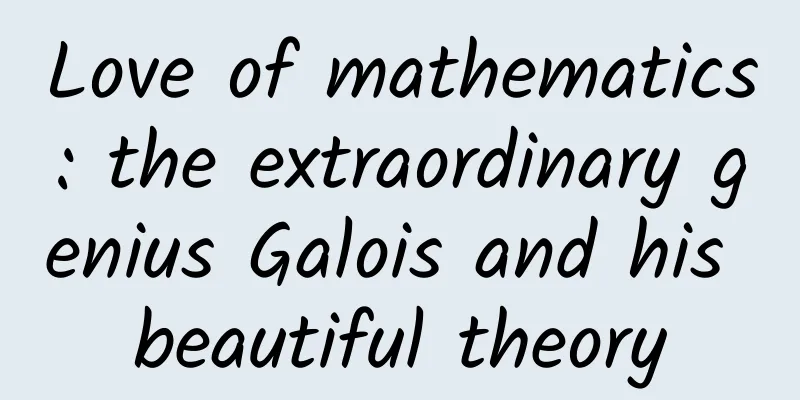Love of mathematics: the extraordinary genius Galois and his beautiful theory

|
The mathematical genius Galois died in a duel at the age of 20, ending his short life, but the essence of his thoughts will always flow in the long river of history. By Kasper Müller Translation | Xu Zhaoqing On the morning of May 30, 1832, a gunshot rang out and Évariste Galois, only 20 years old, fell wounded on the dewy grass. One of the most fascinating and mysterious figures in history was about to die. Galois | Image source: Wikimedia Commons Introduction This is a story about love and mathematics, and about a very smart young man. His scribbled manuscripts opened up one of the most beautiful and interesting areas of mathematics, and also triggered a revolution in how we think about equations. Not only did he solve a 350-year-old problem, his theory also provided answers to several 2,000-year-old problems. We will get to that later. More specifically, Galois considered the problem of finding the roots of polynomials. Mathematicians knew at the time that there was no general formula for finding the roots of polynomials of degree 5 or higher. (By formula here, we mean taking the nth root and applying arithmetic operations. This concept is also called radical solvability, and is referred to as solvability in this article.) However, Galois wanted to understand why some higher-degree polynomials are radical solvable while others are not. (Translator's note: Here, readers can use the formula for finding the roots of quadratic polynomials as an example to understand the concept of radical solvability.) For example, the equation x5-1=0 is solvable, and we call these solutions fifth-order roots of unity. These solutions are beautifully and evenly distributed on the unit circle of the complex plane, which is also the vertex of a regular pentagon, that is, five fifth-order roots of unity. So some polynomial equations of degree d (where d ≥ 5) are, in fact, solvable! The question that Galois theory addresses is exactly why this is the case, and which equations are solvable in radical form, rather than just knowing that some equations are unsolvable. The fact that some polynomial equations are unsolvable was proved by another genius, the young Norwegian mathematician Niels Henrik Abel, and several great mathematicians, such as Paolo Ruffini and Augustin-Louis Cauchy, also contributed to this, but no one came up with a theory close to Galois’s, and no one could explain exactly why. In this article, we will first look at the history and life of Galois, and then briefly touch upon his untimely and mysterious death at the age of 20. After that, we will look at the full scope of his beautiful mathematical theory and discuss why it is so elegant. While it’s impossible to cover all of Galois Theory in one article, I hope I have shown you some of its elegance and beauty, and that it will inspire you to study and explore on your own. Galois Galois was born on October 25, 1811. He was interested in mathematics at an early age, and at the age of 14 he found Adrien-Marie Legendre's Éléments de Géométrie, which he reportedly read "like a novel" and mastered on his first reading. At the age of 15, he began to read Lagrange's papers, which may have been greatly inspired by him. Although Galois worked hard on his own time, he had little motivation in class. In 1828 and 1829, he was rejected twice by the École Polytechnique, the most prestigious mathematics school in France at the time. The first time was because of his poor academic performance, and the second time was because he failed the oral examination, which he reportedly botched. From this moment on, time flies by, and in 1829 Galois published a paper on continued fractions, and around the same time he submitted some papers on polynomial equations. The reviewer was none other than one of the greatest mathematicians of the time: Augustin-Louis Cauchy. However, although Cauchy suggested that Galois submit his paper to the French Academy of Sciences for the Grand Prix, he did not publish Galois's paper. To this day, no one knows why Cauchy didn't publish it. Some say he recognized the importance of Galois's ideas but suggested that Galois make some edits before publishing. Others say that politics played a role. (Apparently, Cauchy and Galois had conflicting political views, which was a big deal at the time.) On July 28, 1829, Galois's father died. Galois had a very close relationship with his father, so for him, this was a heavy blow in life. In 1830, at Cauchy's suggestion, Galois submitted a paper on the theory of equations to another great mathematical figure, Joseph Fourier. Unfortunately, Fourier died soon after, and Galois's paper was lost. This was certainly a setback for Galois, but he did not give up easily. Later that year, he published three papers. One of them outlined what later became known as Galois theory, and another was the first study of the mathematical concept we now call finite fields, which later became very important in the field of number theory. To understand Galois' situation and life, we need to understand what was happening in France at the time. It was in the middle of the July Revolution in France, also known as the Second French Revolution, and Galois not only participated in the revolution, but also participated in battles and debates. He joined the riots in the streets and spent his time on mathematics and politics. The mystery of Galois' death In the years following his father's death, Galois became increasingly violent and was arrested several times. In January 1831, Galois again attempted to publish his theory, but the great mathematician Siméon Denis Poisson considered his work "incomprehensible". Galois was in prison at the time and was furious about Poisson’s rejection, but somehow he took the criticism seriously this time and began to clean up his work and write his account more carefully. Galois was released on April 29, 1832. Shortly afterwards, he participated in a duel. There are many speculations about the famous duel. A letter written by Galois five days before the duel indicates that he was in love and the duel was for his lover. The night before the duel, Galois was convinced that he was about to die, and he stayed up all night writing what would become his greatest contribution to mathematics: the famous letter to Auguste Chevalier expressing his views, and three accompanying manuscripts. The last page of Galois's manuscript丨Image source: Wikimedia Commons Mathematician Hermann Weyl said of the manuscript, "If one judges by the novelty and profundity of the ideas it contains, this letter is perhaps the richest piece of writing in the whole literature of mankind." This is a famous quote from a great man. On the morning of May 30, 1832, Galois was shot in the abdomen and was subsequently abandoned by his opponents. The next morning, Galois, only 20 years old, died. The story after In 1843, Joseph Liouville reviewed Galois's manuscript and declared it correct, and the paper was finally published in 1846, 14 years after Galois's death. However, it took longer for the theory to become popular among mathematicians and for people to truly understand its mysteries. In fact, Liouville completely missed the theoretical core of Galois’ method, Group, which was not fully understood until the turn of the century and established as a core part of abstract algebra. It took nearly a hundred years for this theory to become a standard part of algebra courses. The most famous section of the Galois manuscript is the proof that no formula for finding roots of quintic polynomials exists - that is, quintic and higher-degree polynomial equations in general cannot be solved by radicals. As mentioned above, Abel had already proved in 1824 that the "quintic formula" for solving radicals was impossible, but Galois conducted more in-depth theoretical research and proposed the current Galois theory. This theory can be used to determine whether any polynomial equation has radical solutions. Galois was the first to coin the word "group" and he used the same definition (almost) that we use today in different universities and colleges. He introduced the concepts of normal subgroup and finite field, which we will also discuss later. Essentially, Galois was one of the founders of the field of modern group theory and abstract algebra. Group theory is the study of symmetry and has a wide range of applications in many mathematical and physical disciplines. Abstract algebra is also known as the "language of modern mathematics." I remember clearly that before I studied the Galois theory course, I had already studied many abstract algebra courses, such as Group Theory, Ring and Ideal Theory, Field Theory and Module Theory (module refers to the linear space on the ring, not the field), all of which were very abstract. Then I learned Galois theory, and a lot of what I had learned before, especially group theory and field theory, came into play. In the end, I could use all these abstract mathematical objects to prove why certain polynomial equations had no radical solutions, and that wasn't all Galois theory. This is exactly why I think Galois theory is beautiful. Galois theory Galois theory links two subfields of abstract algebra - group theory and field theory. As mentioned before, the birth of Galois Theory was prompted by the following question: For a polynomial equation of degree 5 or higher, is there a formula that can express all the roots, that is, all the solutions of the equation, by using the coefficients of the polynomial, the usual algebraic operations (addition, subtraction, multiplication, division), and radicals (square root, cube root, etc.)? Although the Abel-Ruffini theorem provided a counterexample that there are polynomial equations for which such an expression does not exist, Galois's theory provided a more complete and clearer answer to the previous question by explaining why some equations, including all equations of degree 4 and lower, are possible to find radical solutions, and why many equations of degree 5 and higher have no radical solutions. Modern Galois theory uses the language of groups and fields, so I will try to explain Galois theory without getting into too much other stuff, but for the sake of completeness we will briefly introduce these mathematical concepts. Group Theory Group theory is the study of symmetries. Imagine a square: this square has a certain symmetry - if you rotate it 90 degrees, it looks the same, and so do 180 and 270 degrees; of course, if you rotate it 360 degrees, it returns to its original state. To keep track of this, we can imagine that the four corners of the square are marked so that we know how to transform. There is also a kind of reflection symmetry, such as choosing an axis, or a line, through the middle of a square that divides it into two equal-sized rectangles. You can flip the square along this line and it will still look the same, but this transformation is different from a rotation. The last type is trivial symmetry (nothing changes). For every symmetry there is an antisymmetry: for example, a 90-degree clockwise rotation followed by a 90-degree counterclockwise rotation will cancel each other out, resulting in a trivial symmetry. This concept can be generalized algebraically. A group G consists of a set and an operation that satisfy the following conditions: 1. For elements g and h in two groups, the operation will result in the element g*h in the group; 2. There exists an identity element e such that any element g remains unchanged after operation with it, g*e=e*g=g; 3. For any element g, there exists an inverse element a such that g*a=a*g=e. In the above examples, the elements of the group are the transformations themselves. For example, a 90-degree rotation and the reflection transformation mentioned above are both elements of the group. We denote the 90-degree rotation as σ and the reflection transformation as τ. The operations of this group are just the composition of transformations. So we can get σ*τ, which means first flip along the axis of symmetry and then rotate 90 degrees. But we can notice that σ*τ≠τ*σ, so the order of element operations is very important in the group. (Translator's note: Let's assume here that the rotation is clockwise and the four corners of the square are numbered, so that readers can verify by drawing that the result of flipping first and then rotating is different from the result of rotating first and then flipping.) So the concept of a group is a way to abstract symmetry. In fact, there are so many groups of abstract transformations that we don't even know how to visualize some of them. But one of the simplest groups is familiar to everyone: the set of all integers and the operation of addition form a group. When we add two integers, we get a third integer (the set is stable with respect to addition). The identity element is 0, because for any integer k, 0+k=k+0=k, and the inverse is just -k, k+(-k)=0. so, is a group. But what symmetry does the group of integers and the addition operation embody? The answer is translation symmetry. Adding an integer k It can be regarded as a translation distance k along the number axis, with positive and negative representing the direction. Domain Theory In mathematics, a field is a special kind of ring. You can think of a field as a set with two operations, usually addition and multiplication, + and *. The addition and multiplication here may not be the usual operations, they depend on the field Before we discuss the beauty of Galois Theory, we need to know what a splitting field is. But it is very simple. Consider an nth-degree polynomial f whose coefficients are all rational numbers. We know from the fundamental theorem of algebra that the nth-degree polynomial f has exactly n complex roots (including the multiplicity of the roots). The last concept is automorphism of a domain K. This is a fancy word for permutations that preserve structure in a domain. If σ is an automorphism of K, then σ(x+y)=σ(x)+σ(y), σ(x*y)=σ(x)*σ(y) And σ is a bijection, that is, this mapping is both injective and surjective. Assume that field K is an extension of field F, that is, F is a subfield of K; we can consider an automorphism σ on K of a fixed field F, such that for any element x of field F, σ(x)=x. The fundamental theorem of Galois theory For a given polynomial, different algebraic equations can relate different roots. (Algebraic equations in this article refer to polynomial equations with rational coefficients.) The main idea of Galois theory is to consider the permutation of roots so that after the permutation, the algebraic equation that was originally satisfied is still valid. The group formed by these permutations is called the Galois group of the polynomial. Solvable Group Galois himself understood and studied it in his famous manuscript at the time. Consider a polynomial f. If the Galois group of f is a solvable group, then the polynomial is solvable by radicals, otherwise it is not. Of course, I also need to tell you what solvable means for a group. Consider a group G and its subgroup H, H < G. We call H a normal subgroup of G if the following condition holds: for an element h in H, and an element g in group G and its inverse a, the element g*h*a∈H. This means that H is invariant under the action of the group G, or under the conjugation of the elements of the group G. More generally, we can construct an equivalence relation from a normal subgroup H and an element of a group G. This requires the use of the theory of cosets, but we do not assume that the reader is familiar with this, as it is outside the scope of this article. So we will just say here that this equivalence relation allows the construction of a new group. Conclusion The beauty of Galois theory is that we can associate every polynomial with a group that holds the algebraic information about its roots. By studying this group, we can translate that algebraic information into the world of polynomials. I mentioned earlier that we can use this theory to prove some very old problems. As a byproduct of Galois's theory, two problems, "doubling the cube" and "squaring the circle," were eventually proved to be impossible. They are both related to the expansion of the field of rational numbers mentioned above. Evariste Galois was undoubtedly a genius of the first order. The times and circumstances brought him many difficulties, and his casualness was considered unconventional in the mathematical community, and to some extent, it is still unacceptable today, because mathematics requires extreme accuracy and care to avoid ambiguity. Mathematicians often use the word "rigorousness" to describe this requirement. But this doesn't mean his theory is incorrect. Galois's theory is correct and beautiful! It is now used in many different areas of mathematics, including Andrew Wiles' proof of Fermat's Last Theorem and algebraic number theory. The idea of using a group to represent another structure is brilliant. This idea is now applied in many fields, such as in algebraic topology, we can study a group to obtain information about the topological space; in algebraic geometry, we can study the solution set of polynomials by using ring theory and ideal theory; the points on the elliptic curve form a group, and so on. Dear reader, if you have made it this far, I hope you have enjoyed this journey through Galois. Let me know in the comments. Thanks for reading. Kasper Müller, For the Love of Mathematics Special Tips 1. Go to the "Featured Column" at the bottom of the menu of the "Fanpu" WeChat public account to read a series of popular science articles on different topics. 2. Fanpu provides a function to search articles by month. Follow the official account and reply with the four-digit year + month, such as "1903", to get the article index for March 2019, and so on. Copyright statement: Personal forwarding is welcome. Any form of media or organization is not allowed to reprint or excerpt without authorization. For reprint authorization, please contact the backstage of the "Fanpu" WeChat public account. |
<<: The Analects of Confucius tells us: Square dancing is the code for traffic!
>>: When you are performing your “inner drama”, who is dubbing for you?
Recommend
Songyuan SEO training: How to distinguish between SEO and Baidu promotion? Which one is suitable for you?
With the development of Internet technology, comp...
Samsung Galaxy Tab Pro review
Galaxy Tab Pro has come to us. Its 8.4-inch screen...
Virtual data is needed at the end of the year, and this is another project that can earn 200 yuan a day!
In recent days, I suddenly had a deep understandi...
Introducing several key points of custom development of small programs
Nowadays, more and more companies realize the adv...
Android policy tightens: Why doesn’t Samsung take advantage of the situation to back off?
Not long ago, when Google launched its first low-...
The highly profitable money-making project of separating the mistress can earn at least tens of thousands per order
Today's society is open enough and more empha...
How to use Xiaohongshu’s algorithm mechanism for oral medical beauty marketing and promotion?
If medical beauty marketing is limited to product...
Lin Dan admitted to cheating! Brands are all thinking, who should be the next spokesperson?
Lin Dan cheated on his wife, and many people are ...
When the product’s daily active users (DAU) decrease, how should product operations analyze it?
In this article, I chose a specific problem to wr...
During the Spring Festival, if you have a sudden heart attack, which emergency medicine should you choose? Check out the expert summary!
Cardiologists are always busy during the Spring F...
Google re-emphasizes upgrade policy, most Android devices continue to be excluded from updates
[[127122]] Due to the large amount of code that n...
Brand development faces challenges? Great Wall Weipai CEO Chen Siying resigns, just 8 months after being appointed
Recently, Chen Siying, CEO of Weipai, a high-end ...
Operational tips: How to use new media to promote products
Before explaining new media operations, let’s fir...
Secret's demise reveals Silicon Valley startups' "flash in the pan" trend
A twist of fate Last summer, employees of the sta...
HTML 5 melee: Chrome, Safari, Firefox, IE and Opera each show their strengths
Chrome and Opera are better at supporting the lat...









